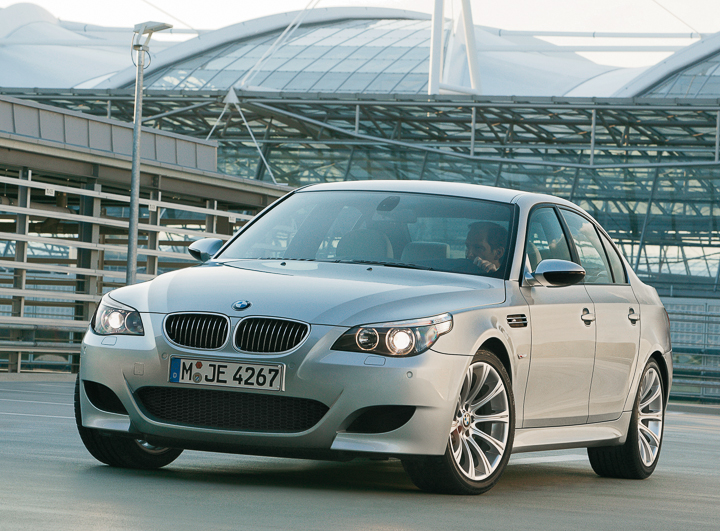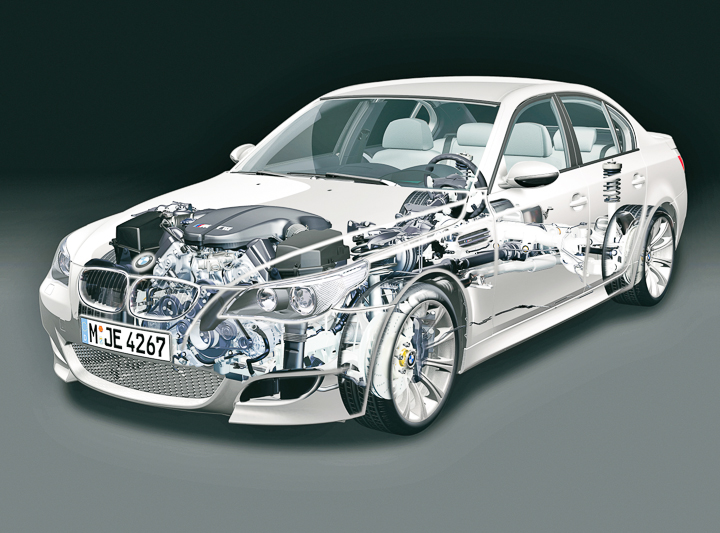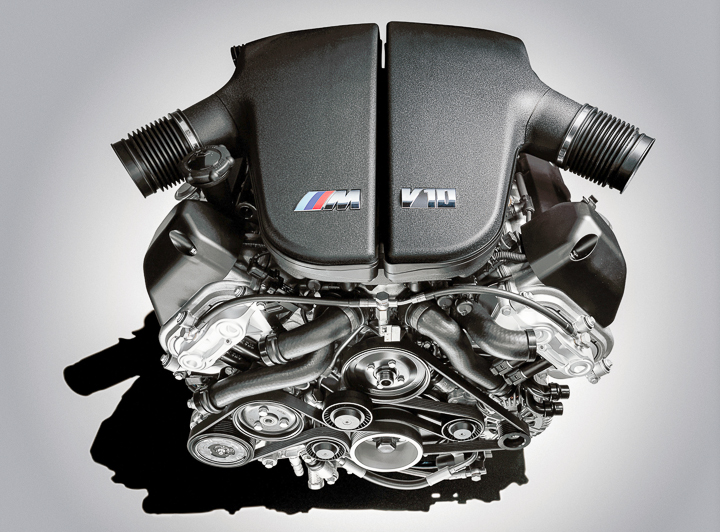Considering all the things that have been said about it – its fuel tank is too small, its gearbox too gruff, and in neutral it sounds more like a diesel than a sports car – it is all the more interesting to note that demand for it was greater than for any of the model’s preceding versions. We are referring of course to the fourth-generation BMW M5 from 2005, a build with more than a few rough edges.
And you can tell the moment you cast your eyes on it. Instead of the soft and pleasant forms of a more ‘organic’ design, the E60 series had an ‘architectural’ flavour, with its sharp edges and straight surfaces. As surprising as this might have been at first sight, the fourth generation of this wolf in sheep’s clothing still appears modern by today’s standards.
The outer appearance lived up to all of its promises. Not only was it kitted out in new clothing, but the internal design also reflected new values, with terms like V10, SMG, EDC, HUD, and others. The fourth M5 was a veritable monster of innovation; BMW M GmbH had driven its creative power towards a new peak.
As with all new products, a press folder was compiled for the latest generation of the BMW M5. A date was set in advance on which all of the new features and modifications that this car featured compared with the top model, the BMW 545i, would be recorded. According to legend, an hour was set for this purpose, but in the end three were needed, and another two dates followed, of similar length. In this context, the former head of technical operations, Gerhard Richter, is oft quoted with the words: ‘good that there wasn’t a controller anywhere’.
Was the V10 chosen because BMW had recently returned to Formula 1? Is the identified power output of 507 bhp intended as a reminder of the famed Roadster? And does the 7-speed SMG really only last for 250 racing starts?
To this day, V10 engines are regarded as exotic. The wish had been expressed at an early stage to implement a considerable increase in engine power compared to the 400 bhp predecessor, ever since the initial plans for the BMW M5 E60. While the BMW M5 was regarded at the time as the undisputed king of the jungle, the competition was for its part also about to raise the stakes more than just slightly. For this reason, the decision was taken to increase the engine power by as much as a quarter. The V8 engine of the predecessor was not able to produce an output of such dimensions, and it appeared to make just as little since to ‘soup up’ the 545i engine. So the only way of achieving the goal was to come up with a completely new M engine. While a volume of 333 cubic centimetres per cylinder is regarded as an ideal dimension in motor racing, for serial engines, the figure is 500 cm³. Assuming that 100 bhp per litre represents the peak of performance with naturally aspirated engines, then the result is an engine size of five litres and, correspondingly, 10 cylinders.
As useful as this might have been for marketing purposes, it was all down to sober engineering logic. And everybody was happy. The fact that the engine blocks originated from the same foundry as those for Formula 1 was seen as evidence of the car’s technical association with motor racing. In reality, this existed only indirectly, in the processes, materials and methods involved. The 507 bhp that were ultimately produced were not in homage to the most expensive present-day BMW but resulted from the American method of measuring engine output. With exactly 400 bhp, the preceding model’s position remained the same in the main sales market of the USA, at 394 SAE bhp. However, a number with a ‘5’ in front was also deemed necessary in the United States, to make it perfectly clear that the new boy was already the man in the house.
A central component of the drive train, and of equal importance, was the seven-speed M SMG Drivelogic transmission. In contrast to previous versions of SMG, this was not a manual transmission that was subsequently modified into an automatic design. Right from the start, automatic transmission was part of the design and the conscious decision was taken to abandon all thoughts of a manual gearbox. This was not least down to the arrangement of the gears. The distribution of the shafts evolved by taking into consideration the forces acting in the gearbox – the highest momentum levels occurring at the lowest gears – and optimised shifting times. For instance, the lower gears are located as close to the casing as possible. As a result, the change from first to second follows the familiar H formation from top-left to bottom-right – and this with four channels. For a manual version, this would have been an adventure in itself.
Moreover, the racing start function, or ‘launch control’ had been subjected to further refinement. The technology was able to protect itself. A certain travel distance and cooling interval was provided for between two racing starts. And the on-board electronics counted the number of racing starts. The maximum number catered for was 250. At this point, the counter stopped counting, although the function remained available without any limitations. The maximum stresses encountered during a racing start do not have a direct effect on the gearbox but all the more on the clutch and the vehicle body.
The engine and transmission may have been the main features of the innovative design, but there were also many other areas in which the fourth BMW M5 went its own way. For example the adaptive chassis control or EDC. Three different modes were available, from a comparatively comfortable ‘mother-in-law’ setting to a racetrack mode. The previous model had a variable warning field for the engine oil temperature, made up of LEDs positioned within the tachometer. Sports-oriented drivers in particular will be glad to know that the car is not going to be starting up directly with the oil still warm from the previous drive. The engineers at BMW AG thought this was such a good idea that they provided all drivers of the E60 series with this function. The use of disc pointers did not allow the implementation of the shift lights familiar from the BMW M3 E46. Reason enough for the M engineers to take a closer look at the head-up display (HUD). This gave rise to the ‘M view’, which restricted itself to all the essential information: gear, speed and engine speed. The engine speed is displayed in a dynamic strip and gearshifts by flashing shift lights directly in the driver’s field of view.
However, the crowing achievement of the innovation was to come with the steering. The Garching engineers considered the innovative active steering system offered with the basis vehicle inappropriate for a sports car. It was important that the steering ratio did not change with respect to speed; otherwise, under certain circumstances, it could be confusing to sport drivers. The solution was as simple as it was forward-looking: the steering ratio was made to be more direct with increasing steering angles. This keeps the car confident in the middle position and wonderfully direct with large steering angles. And all of this at any speed, all for the purpose of maintaining constant and predictable driving behaviour.
Clearly, this principle is not only ingeniously simple but also simply ingenious. It is not for nothing that the variable sports steering offered in several BMW series today follows this principle.
Where the lights are bright you will always find a shadow lurking somewhere, and when you are looking for new ways, you will occasionally walk down a blind alley. Or to be more precise, the ‘active backrest width control’ which occasionally put considerable stress on the driver’s ribs in fast curves is no longer offered as an optional extra.
In the end, what counts is what the combination of what all this high-tech produces.
And what it produces is something that even today feels unique. All BMW M5 cars are deserving of their nickname: the ‘businessman’s express’. Or at least nearly all of them. Because where previous generations radiated a high degree of relaxed confidence, the fourth BMW M5 appeared more like a ‘businessman on ecstasy’. The fast-rotating V10 engine with its unusual sound, maximum engine speed of 8,250 rpm, and light-footed driving sensation were enough to turn a sports limousine into a racing car. It is hungry for bends and cries out for higher engine speeds; and its precise handling on the road is simply infectious.
Fortunately, the BMW M5 E60 also comes with a built-in restraining element: its fuel tank dimensions are relatively small for the consumption of the V10 engine, which forces more ambitious drivers into the reserve range after around 200 kilometres.
Luxury on the inside and a fantastic inferno beneath the bonnet that sets an unbelievable counterpoint upon reaching its crescendo between 6,000 rpm and maximum engine speed. It somehow doesn’t seem right. And yet it does. An overall package whose contradictions come together to form something quite unique. Certainly, the fourth generation of the BMW M5 is not everybody’s favourite. But it doesn’t even want to be. It has its own character that makes it quite distinct from all the others. With a production period of only about five years, a total of 19,523 limousines were sold while the Touring version found 1,025 owners. These figures also exceeded those of its predecessors. So what we have here is a genuine success. When you have character, you will make your own way in life.
[Source: M-Power]











































































